Design of Hybrid Fractal Integrated Half Mode SIW Band Pass Filter with CSRR and Minkowski Defected Ground Structure for Sub-6 GHz 5G Applications
Abstract
1. Introduction
2. Design of Proposed Hybrid Fractal
3. Design of HMSIW BPF Integrated with Hybrid Fractal
4. Design of HMSIW BPF Integrated with CSRR Etched on the Bottom Plane
5. Design of Proposed Fractal HMSIW BPF Integrated with CSRR and Fractal DGS Etched on the Bottom Plane
6. Fabrication and Result Discussion
7. Conclusions
Author Contributions
Funding
Institutional Review Board Statement
Informed Consent Statement
Data Availability Statement
Acknowledgments
Conflicts of Interest
References
- Gomez-Barquero, D.; Li, W.; Fuentes, M.; Xiong, J.; Araniti, G.; Akamine, C.; Wang, J. 5G for Broadband Multimedia Systems and Broadcasting. IEEE Trans. Broadcast. 2019, 65, 351–355. [Google Scholar] [CrossRef]
- Erunkulu, O.O.; Zungeru, A.M.; Lebekwe, C.K.; Mosalaosi, M.; Chuma, J.M. 5G Mobile Communication Applications: A Survey and Comparison of Use Cases. IEEE Access 2021, 9, 97251–97295. [Google Scholar] [CrossRef]
- Bozzi, M.; Georgiadis, A.; Wu, K. Review of substrate-integrated waveguide circuits and antennas. IET Microw. Antennas Propag. 2011, 5, 909–920. [Google Scholar] [CrossRef]
- Muchhal, N.; Srivastava, S. Review of recent trends on miniaturization of substrate integrated waveguide (SIW) components. In Proceedings of the 2017 3rd IEEE International Conference on Computational Intelligence & Communication Technology (CICT), Ghaziabad, India, 9–10 February 2017; pp. 1–6. [Google Scholar]
- Muchhal, N.; Srivastava, S. Design of miniaturized high selectivity folded substrate integrated waveguide band pass filter with Koch fractal. Electromagnetics 2019, 39, 571–581. [Google Scholar] [CrossRef]
- Muchhal, N.; Chakraborty, A.; Vishwakarma, M.; Srivastava, S. Slotted Folded Substrate Integrated Waveguide Band Pass Filter with Enhanced Bandwidth for Ku/K Band Applications. Prog. Electromagn. Res. 2018, 70, 51–60. [Google Scholar] [CrossRef]
- Muchhal, N.; Srivastava, S. Compact selective substrate integrated waveguide bandpass filter with S-shaped broadside-coupled complementary split ring resonators (BC-CSRR). Int. J. Microw. Opt. Technol. 2020, 15, 440–448. [Google Scholar]
- Muchhal, N.; Srivastava, S. Design of Compact and Wideband Comb shape SIW Multimode Resonator Band Pass filter. Int. J. RF Microw. Comput.-Aided Eng. 2019, 29, e21807. [Google Scholar] [CrossRef]
- Yang, T.; Chi, P.; Xu, R.; Lin, W. Folded Substrate Integrated Waveguide Based Composite Right/Left-Handed Transmission Line and Its Application to Partial $H$-Plane Filters. IEEE Trans. Microw. Theory Tech. 2013, 61, 789–799. [Google Scholar] [CrossRef]
- Wong, S.W.; Chen, R.S.; Lin, J.Y.; Zhu, L.; Chu, Q.X. Substrate Integrated Waveguide Quasi-Elliptic Filter Using Slot-Coupled and Microstrip-Line Cross-Coupled Structures. IEEE Trans. Compon. Packag. Manuf. Technol. 2016, 6, 1881–1888. [Google Scholar] [CrossRef]
- Duraisamy, T.; Barik, R.; Qingsha, S.C.; Selvajyothi, K.; Karthikeyan, S.S. Miniaturized SIW filter using D-shaped resonators with wide out-of-band rejection for 5G applications. J. Electromagn. Waves Appl. 2020, 34, 2397–2409. [Google Scholar] [CrossRef]
- Iqbal, A.; Jiat Tiang, J.; Kin Wong, S.; Alibakhshikenari, M.; Falcone, F.; Limiti, E. Multimode HMSIW-Based Bandpass Filter with Improved Selectivity for Fifth-Generation (5G) RF Front-Ends. Sensors 2020, 20, 7320. [Google Scholar] [CrossRef]
- Mandelbort, B.B. The Fractal Geometry of Nature; W.H. Freeman and Company: San Francisco, CA, USA, 1983. [Google Scholar]
- Tripathi, S.; Mohan, A.; Yadav, S. Ultra-wideband antenna using Minkowski-like fractal geometry. Microw. Opt. Technol. Lett. 2014, 56, 2273–2279. [Google Scholar] [CrossRef]
- Sharma, N.; Bhatia, S.S. Comparative analysis of hybrid fractal antennas: A Review. Int. J. RF Microw. Comput.-Aided Eng. 2021, 31, e22762. [Google Scholar] [CrossRef]
- Debnath, L. A brief historical introduction to fractals and fractal geometry. Int. J. Math. Educ. Sci. Technol. 2006, 37, 29–50. [Google Scholar] [CrossRef]
- Hong, W.; Liu, B.; Wang, Y.Q. Half Mode Substrate Integrated Waveguide: A New Guided Wave Structure for Microwave and Millimeter Wave Application. In Proceedings of the 2006 Joint 31st International Conference on Infrared Millimeter Waves and 14th International Conference on Teraherz Electronics, Shanghai, China, 18–22 September 2006; p. 219. [Google Scholar]
- Zamzam, K.; Bornemann, J. Designing the width of substrate integrated waveguide structures. IEEE Microw. Wirel. Compon. Lett. 2003, 23, 518–522. [Google Scholar]
- Muchhal, N.; Srivastava, S.; Elkhouly, M. Analysis and Design of Miniaturized Substrate Integrated Waveguide CSRR Bandpass Filters for Wireless Communication. In Recent Microwave Technologies; IntechOpen: London, UK, 2022. [Google Scholar] [CrossRef]
- Jiang, W.; Shen, W.; Zhou, L.; Yin, W.-Y. Miniaturized and high-selectivity substrate integrated waveguide (SIW) bandpass filter loaded by complementary split-ring resonators (CSRRs). J. Electromagn. Waves Appl. 2012, 26, 1448–1459. [Google Scholar] [CrossRef]
- Dong, Y.D.; Yang, T.; Itoh, T. Substrate Integrated Waveguide Loaded by Complementary Split-Ring Resonators and Its Applications to Miniaturized Waveguide Filters. IEEE Trans. Microw. Theory Tech. 2009, 57, 2211–2223. [Google Scholar] [CrossRef]
- Yoonjae, L.; Tse, S.; Yang, H.; Parini, C.G. A compact microstrip antenna with improved bandwidth using complementary split-ring resonator (CSRR) loading. In Proceedings of the 2007 IEEE Antennas and Propagation Society International Symposium, Honolulu, HI, USA, 9–15 June 2007; pp. 5431–5434. [Google Scholar]
- Zhang, J.; Cui, B.; Lin, S.; Sun, X.W. Sharp-Rejection Low-Pass Filter with Controllable Transmission Zero using Complementary Split Ring Resonators (CSRRs). Prog. Electromagn. Res. PIER 2007, 69, 219–226. [Google Scholar] [CrossRef][Green Version]
- Weiping, L.; Zongxi, T.; Xin, C. Design of a SIW Bandpass Filter Using Defected Ground Structure with CSRRs. Hindawi Act. Passiv. Electron. Compon. 2017, 2017, 1606341. [Google Scholar]
- Ali, A.R.; Abdel, R.S.; Omar, A.S. Direct and cross-coupled resonator filters using defected ground structure (DGS) resonators. In Proceedings of the 2005 European Microwave Conference, Paris, France, 4–6 October 2005; pp. 1275–1278. [Google Scholar]
- Hadarig, R.C.; De Cos, G.; Las-Heras, F. A Compact Band-Pass Filter with High Selectivity and Second Harmonic Suppression. Materials 2013, 6, 5613–5624. [Google Scholar] [CrossRef]
- Arya, A.K.; Kartikeyan, M.V.; Patnaik, A. Defected Ground Structure in the perspective of Microstrip Antennas: A Review. Frequenz 2010, 64, 79–84. [Google Scholar] [CrossRef]
- Zhang, Y.L.; Hong, W.; Wu, K.; Chen, J.X.; Tang, H.J. Novel substrate integrated waveguide cavity filter with defected ground structure. IEEE Trans. Microw. Theory Tech. 2005, 53, 1280–1286. [Google Scholar] [CrossRef]
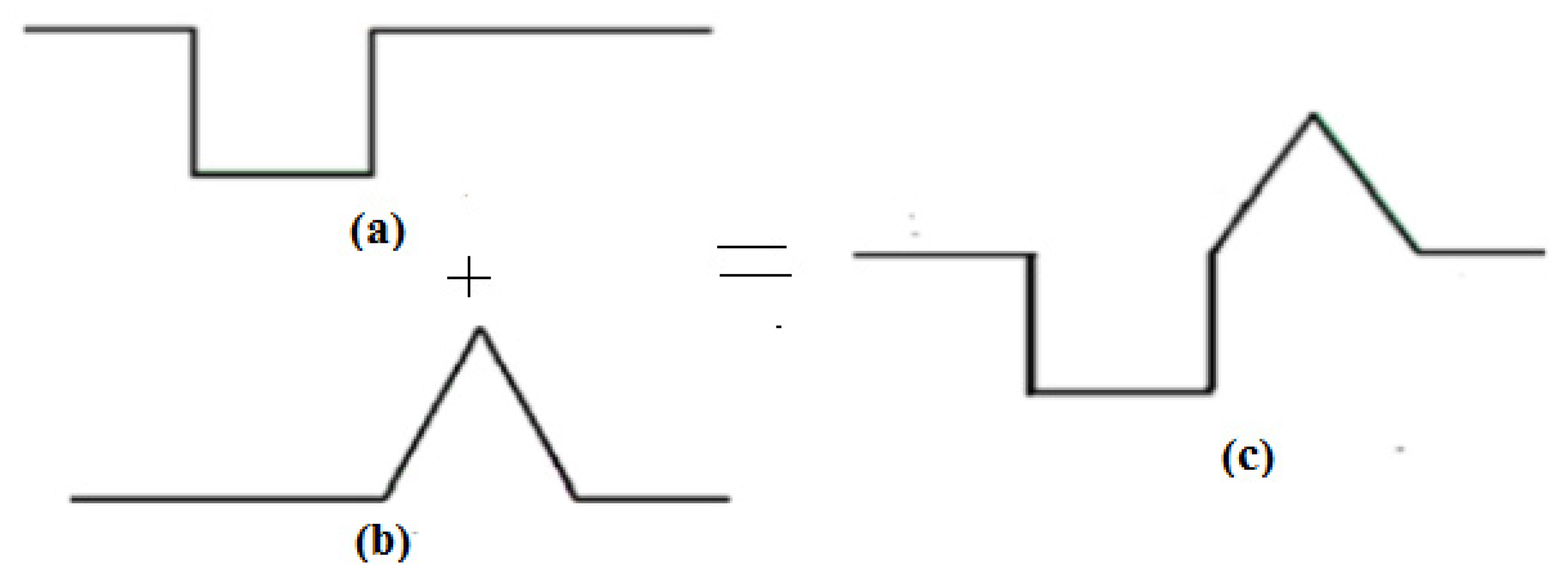

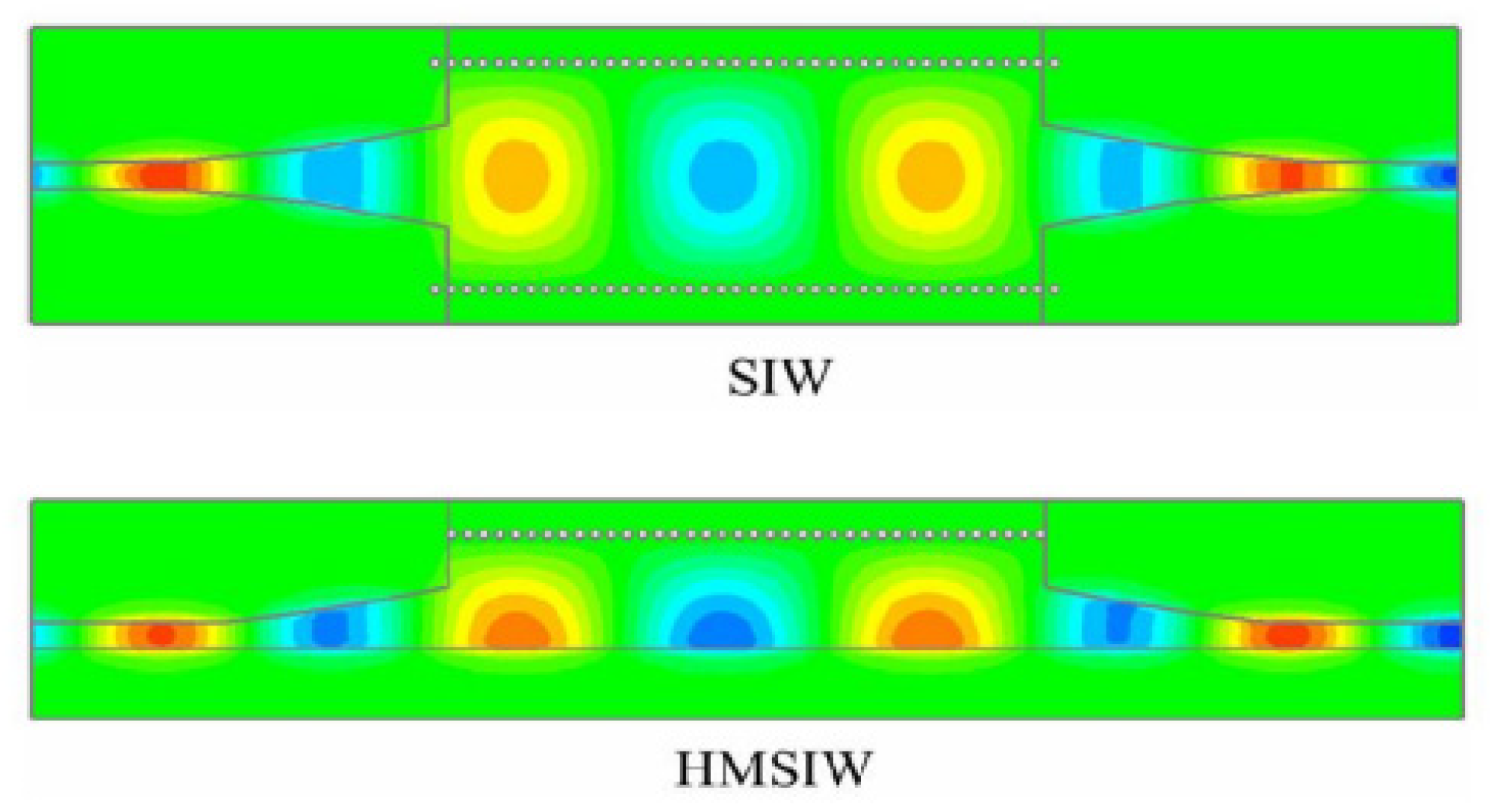
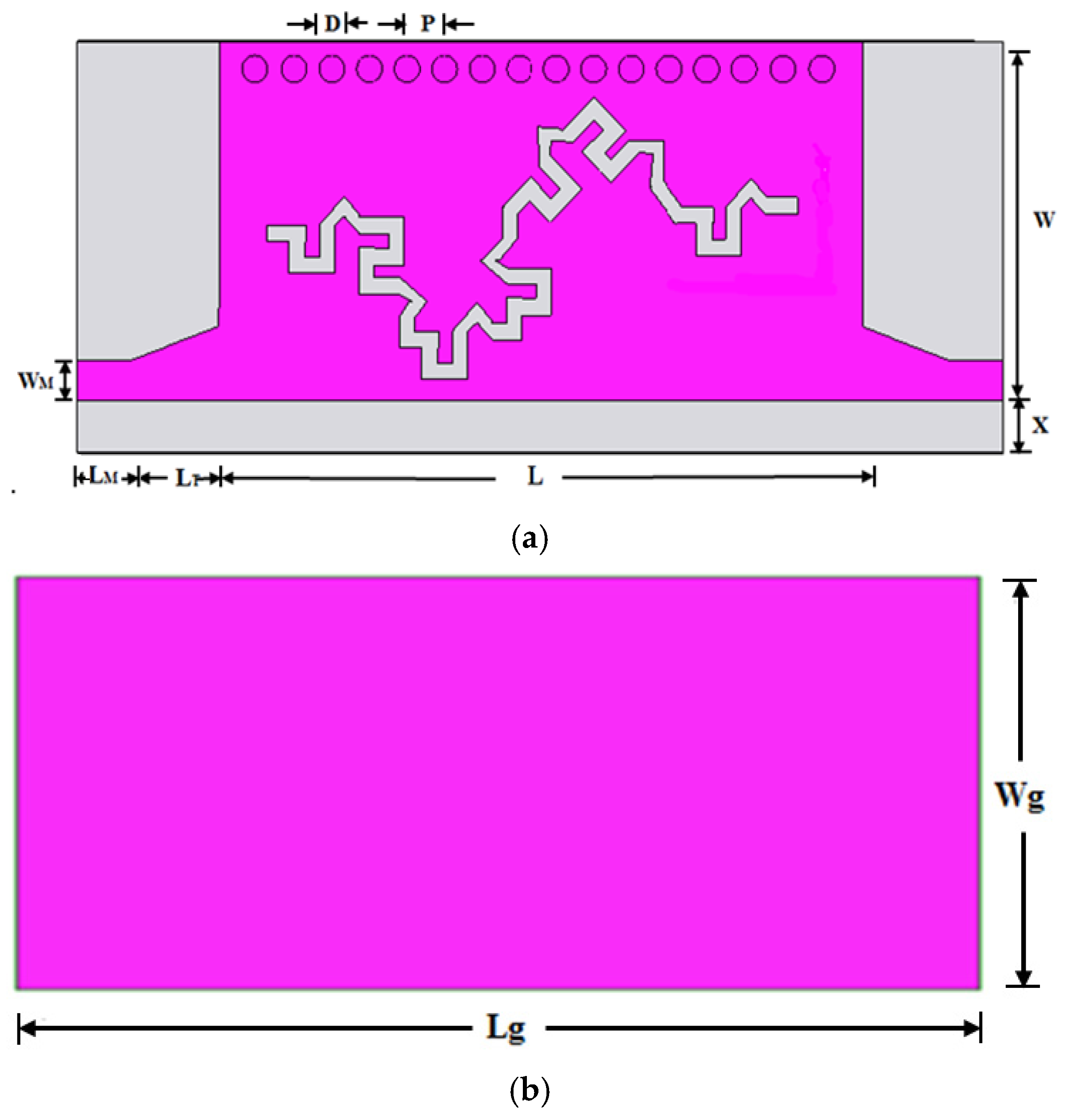
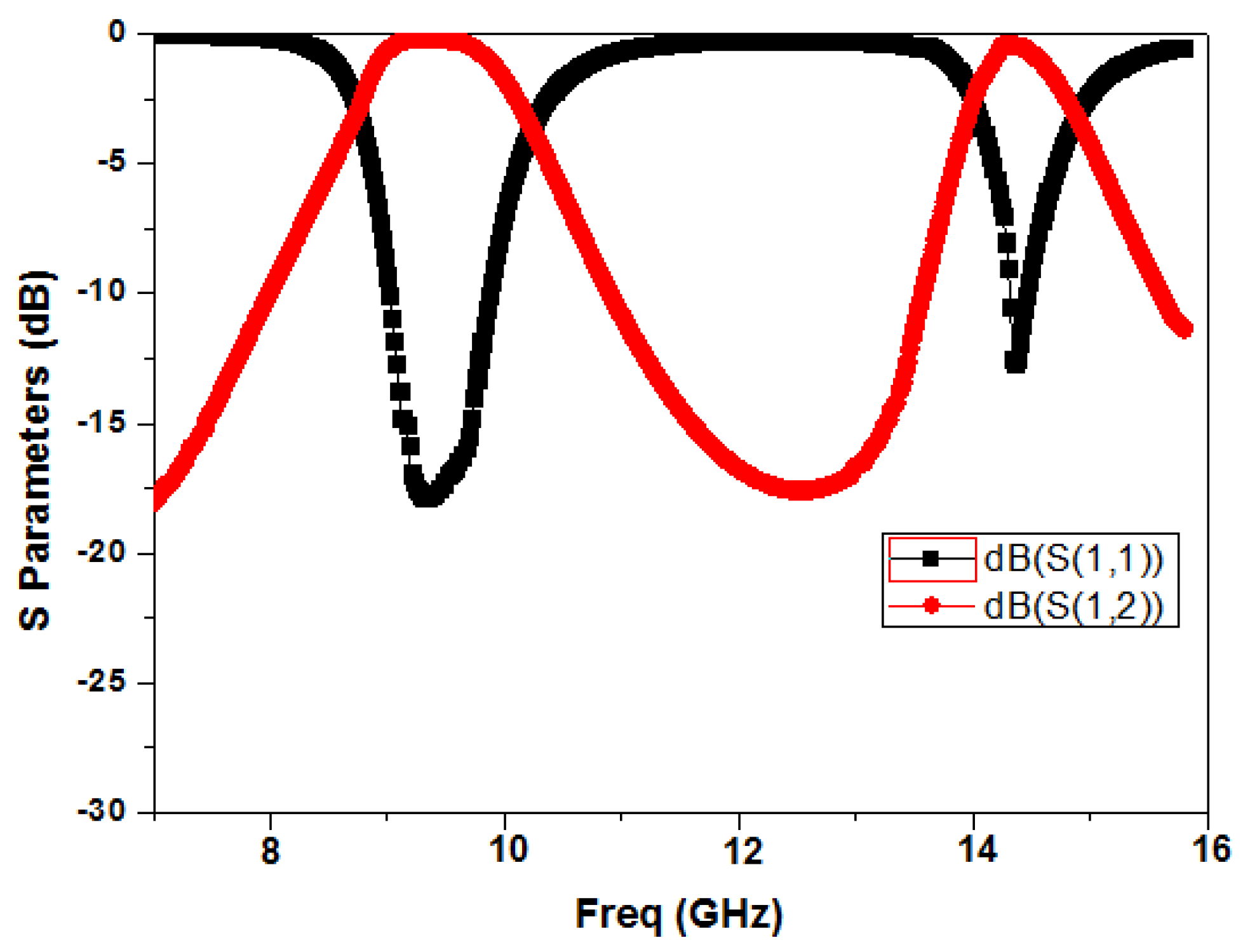
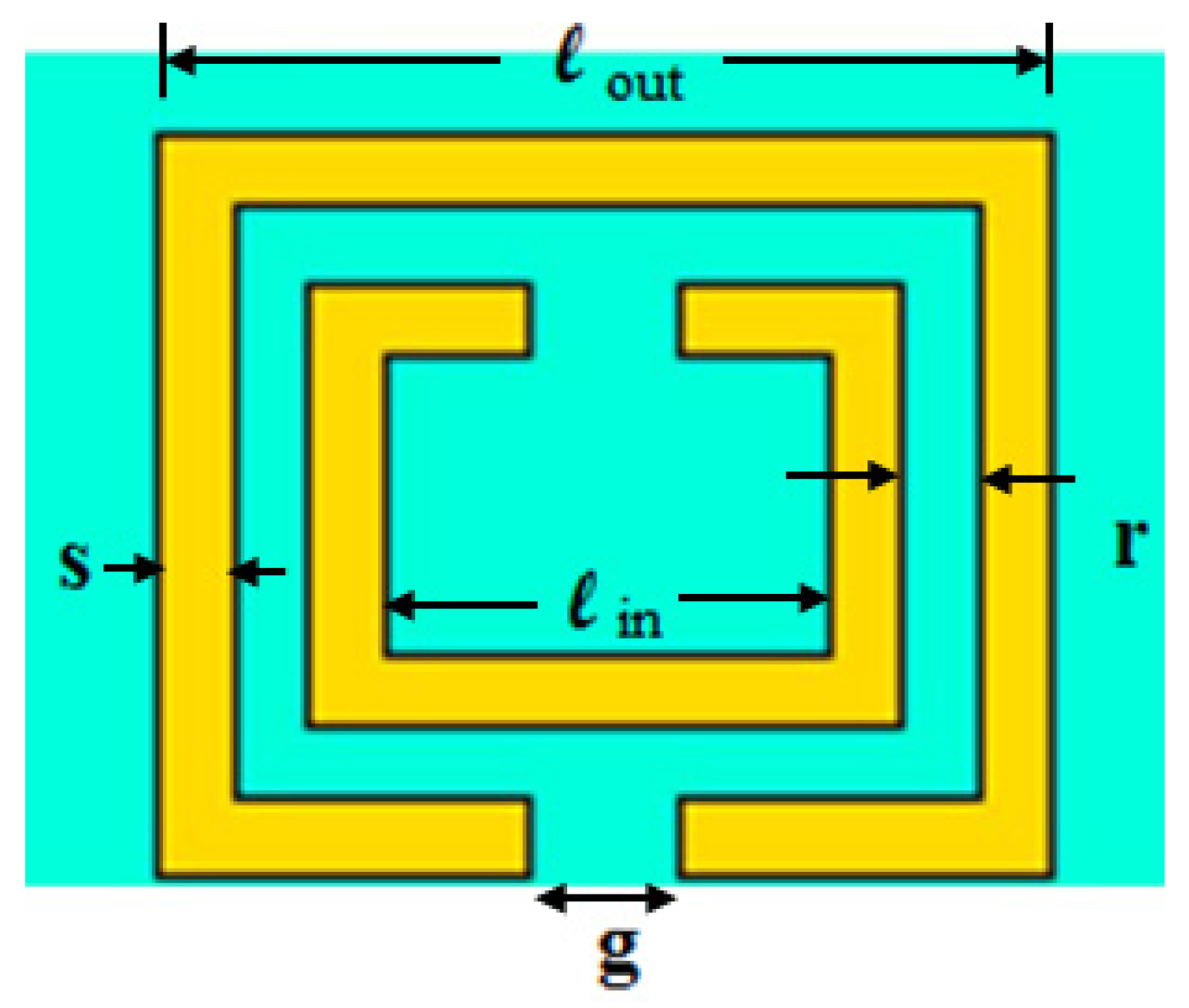
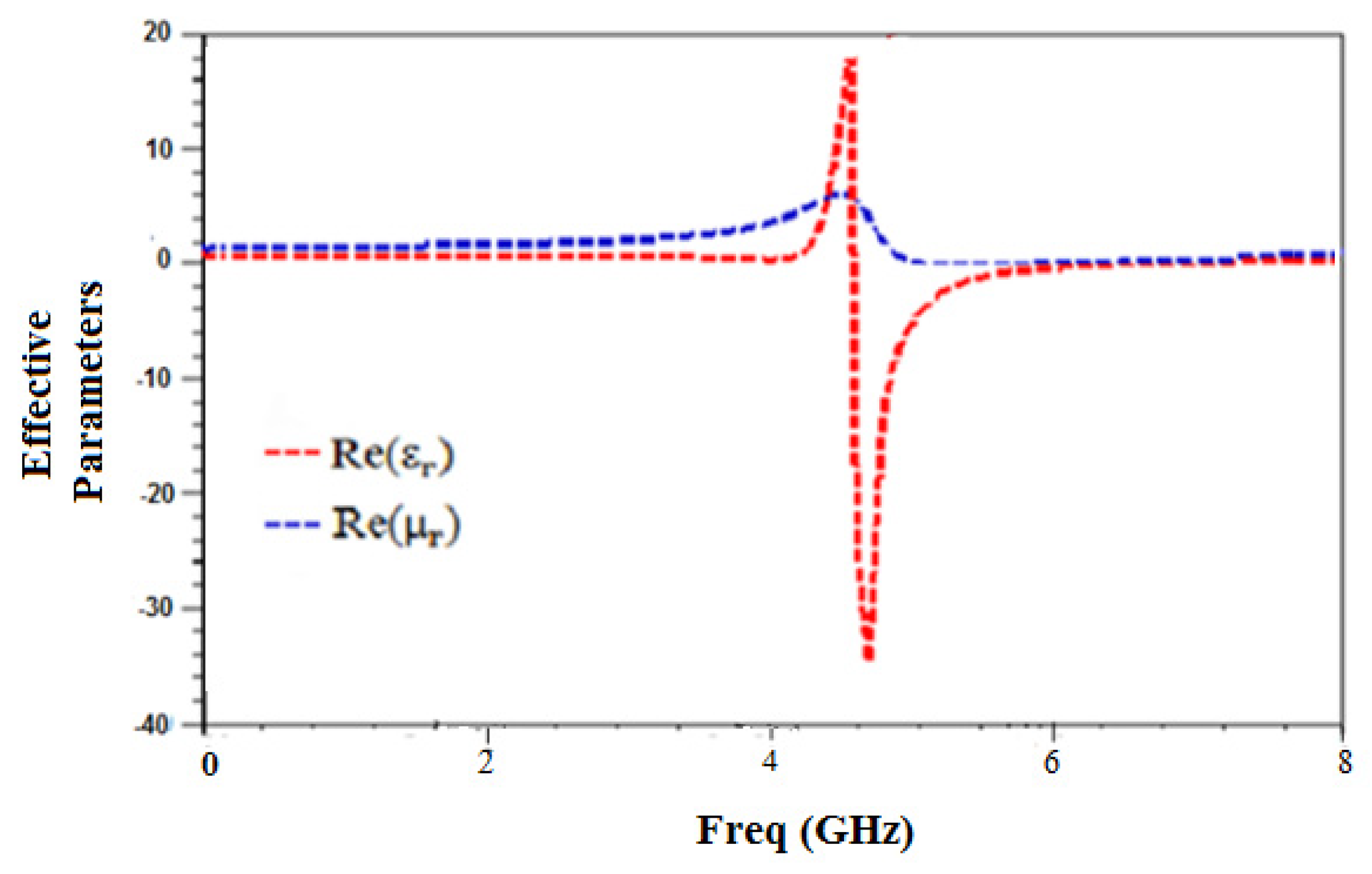
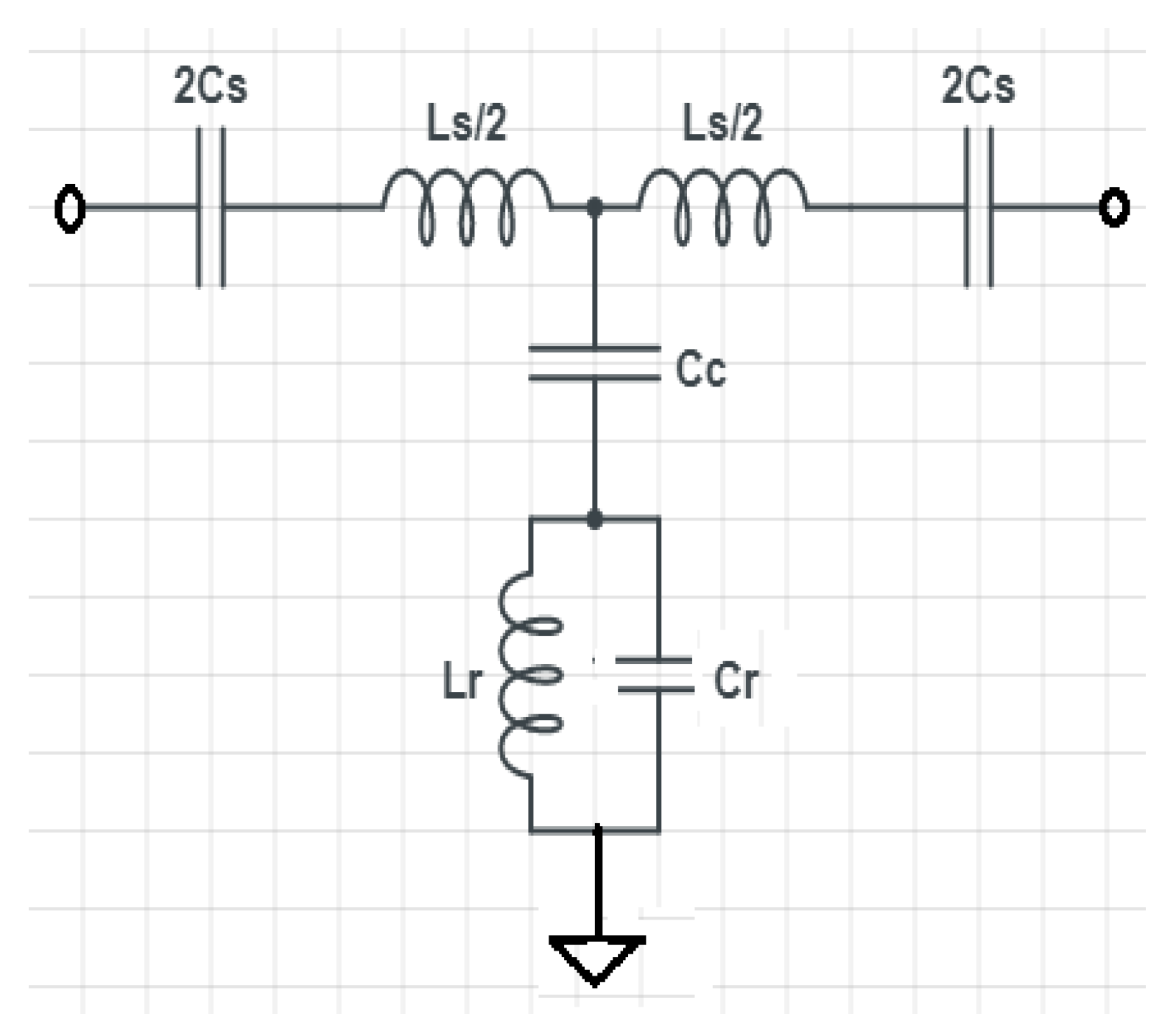
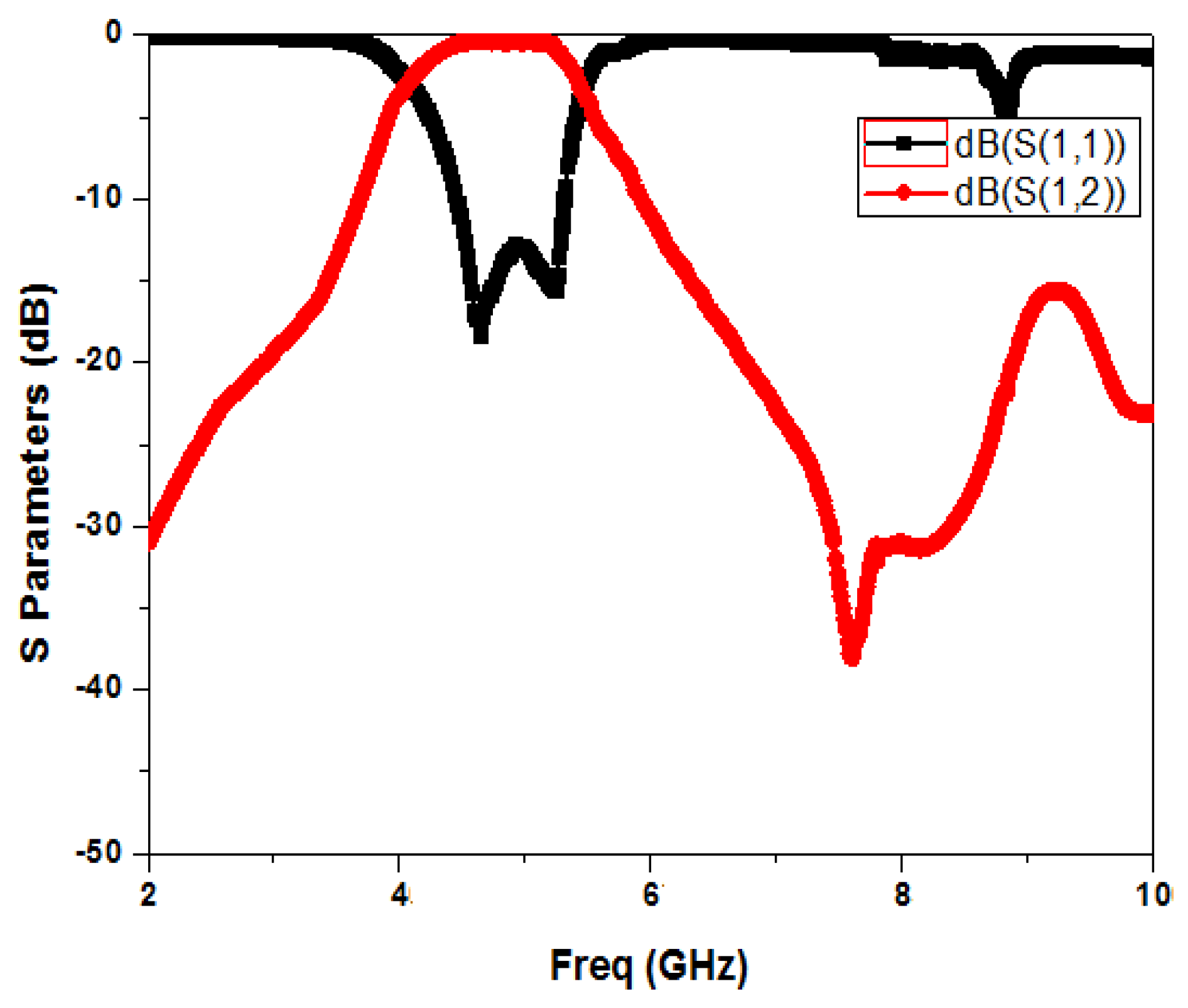

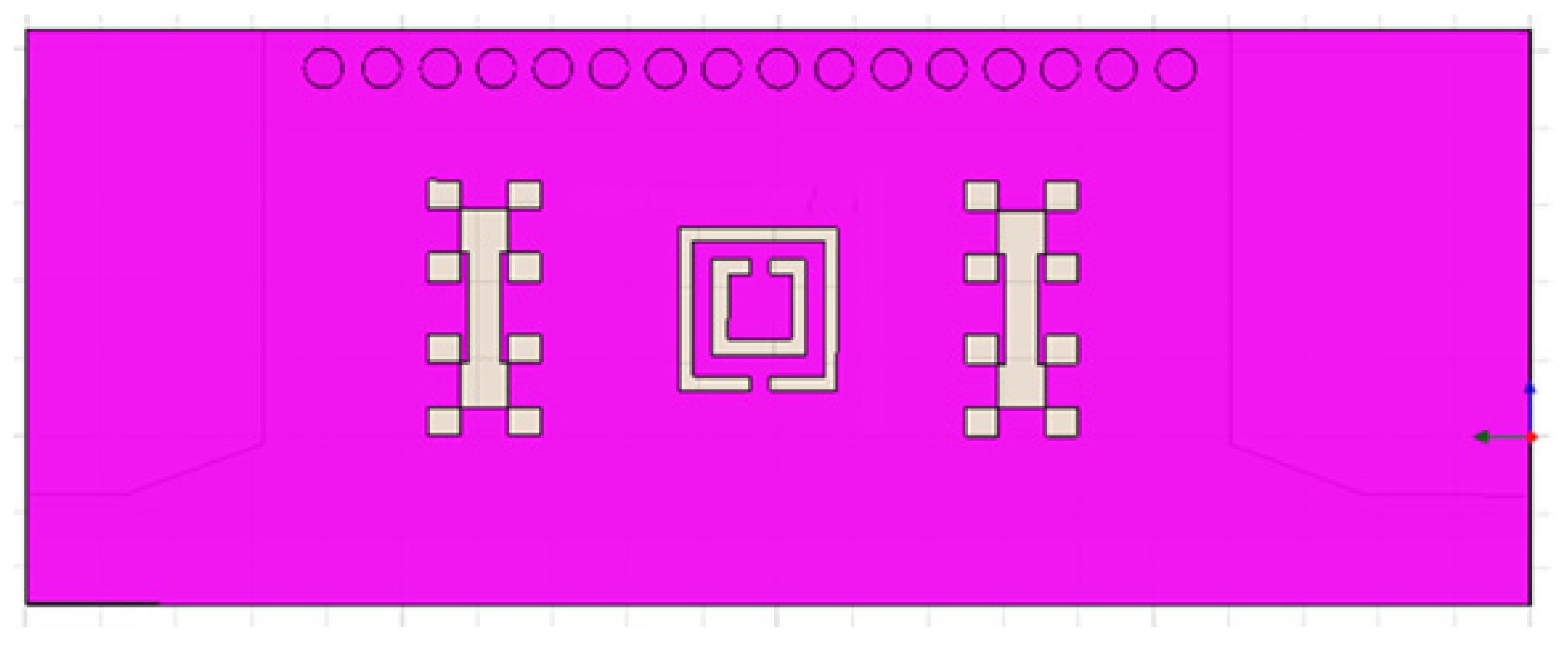
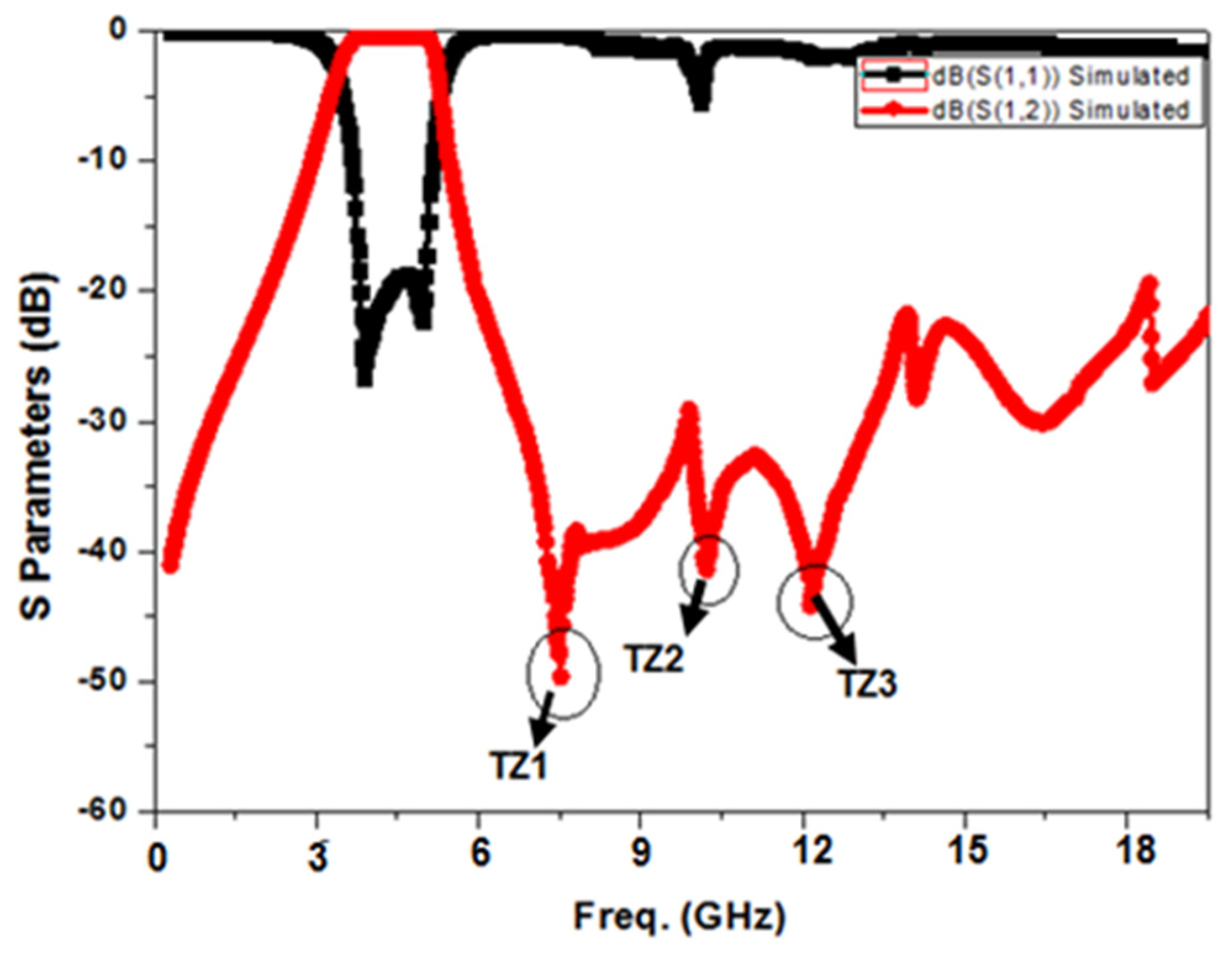

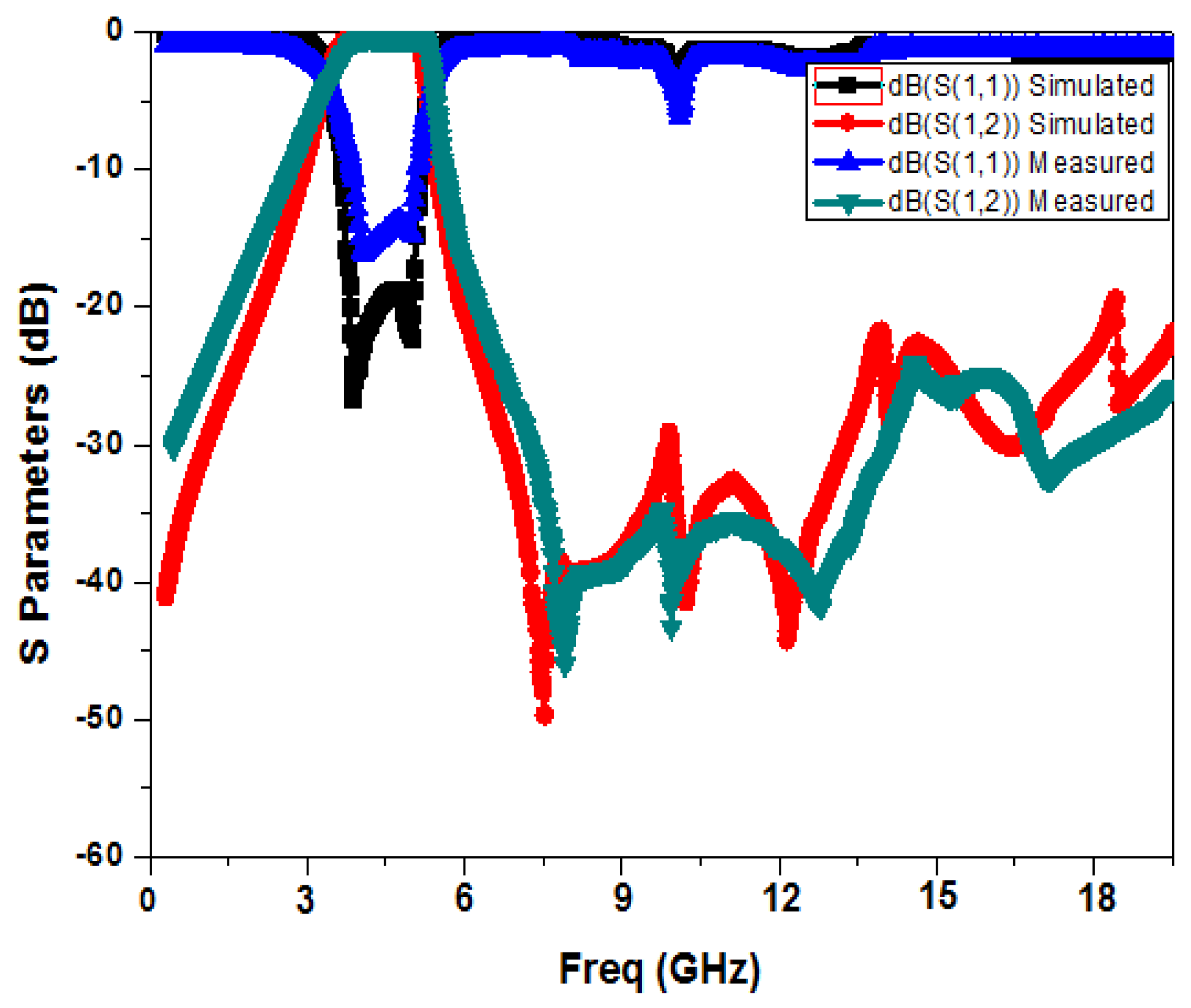
| Reference | fo (GHz) | RL/IL * | Technique Used | Avg. Roll-off Rate # (dB/GHz) | 3-dB FBW (%) | Out-of-Band Rejection (>−20 dB) | mm × mm (λ0 × λ0) |
|---|---|---|---|---|---|---|---|
| [9] | 5.3 | 20/1.8 | FSIW technique | 46 | 6.2 | 0.68 fo | 29.6 × 7.6 (0.62 λ0 × 0.26 λ0) |
| [10] | 3.7 | 18/1.1 | Slot and cross-coupling technique | 57.5 | 14.2 | N.A. | 120 × 30 (1.47 λ0 × 0.37 λ0) |
| [11] | 6.11 | 19/1.2 | CSRR | 52.5 | 8.9 | 3.28 fo | 25 × 9.5 = 237.5 (0.52 λ0 × 0.19 λ0) |
| [12] | 4.67 | 15/1 | Multimode HMSIW | 64.5 | 69.3 | 0.65 fo | 43.5 × 29.5 (0.69 λ0 × 0.46 λ0) |
| Proposed | 5.2 | 14.5/1.1 | HMSIW with DGS and CSRR | 72 | 26.3 | 4.1 fo | 27.8 × 7.25 (0.55 λ0 × 0.21 λ0) |
Publisher’s Note: MDPI stays neutral with regard to jurisdictional claims in published maps and institutional affiliations. |
© 2022 by the authors. Licensee MDPI, Basel, Switzerland. This article is an open access article distributed under the terms and conditions of the Creative Commons Attribution (CC BY) license (https://creativecommons.org/licenses/by/4.0/).
Share and Cite
Muchhal, N.; Elkhouly, M.; Vintimilla, R.Z.; Chakraborty, A.; Srivastava, S. Design of Hybrid Fractal Integrated Half Mode SIW Band Pass Filter with CSRR and Minkowski Defected Ground Structure for Sub-6 GHz 5G Applications. Photonics 2022, 9, 898. https://doi.org/10.3390/photonics9120898
Muchhal N, Elkhouly M, Vintimilla RZ, Chakraborty A, Srivastava S. Design of Hybrid Fractal Integrated Half Mode SIW Band Pass Filter with CSRR and Minkowski Defected Ground Structure for Sub-6 GHz 5G Applications. Photonics. 2022; 9(12):898. https://doi.org/10.3390/photonics9120898
Chicago/Turabian StyleMuchhal, Nitin, Mostafa Elkhouly, Renato Zea Vintimilla, Arnab Chakraborty, and Shweta Srivastava. 2022. "Design of Hybrid Fractal Integrated Half Mode SIW Band Pass Filter with CSRR and Minkowski Defected Ground Structure for Sub-6 GHz 5G Applications" Photonics 9, no. 12: 898. https://doi.org/10.3390/photonics9120898
APA StyleMuchhal, N., Elkhouly, M., Vintimilla, R. Z., Chakraborty, A., & Srivastava, S. (2022). Design of Hybrid Fractal Integrated Half Mode SIW Band Pass Filter with CSRR and Minkowski Defected Ground Structure for Sub-6 GHz 5G Applications. Photonics, 9(12), 898. https://doi.org/10.3390/photonics9120898





